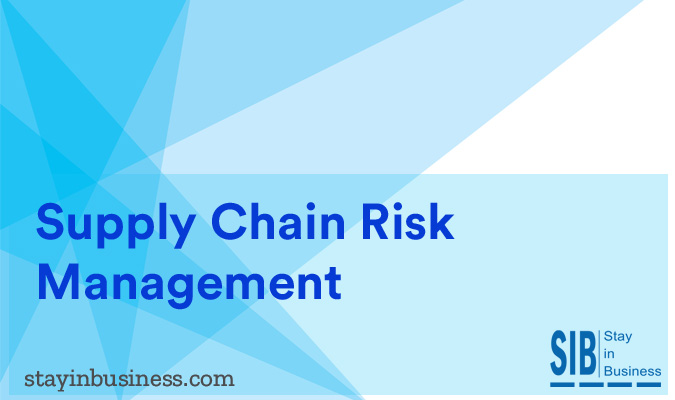
In today’s business world, supply chain risk management issues are the primary threat factor to an organization’s revenue.
Causes for Supply Chain Disruptions
- Speed – Business operations are constantly innovating and growing at a rapid rate
- Competition – Profit margins are narrower. It is not easy to distinguish oneself
- Cost Effectiveness – Organizations are forced to adopt Lean methodologies, improve process efficiencies and control expenditure
- Quicker Turnaround Times – Just in time (JIT) & Agile methodologies, Short-spanned product lifecycles
- Broader Scope – Operations are conducted on a global scale
- Reduction – Alternate vendor options, Vendor managed inventories, Resources
- Constant Transformation – Evolving requirements, Collaborative Planning, Forecasting and Replenishment (CPFR), Technological changes
- Load – Hectic schedules, High production volumes
Supply Chain Challenges
- Impact on reputation owing to more than tolerable disruptions
- Lead times between receiving an order and delivery are constantly increasing
- Growing pressure from leadership and upper management teams
- Rising demands of customers and stakeholders
- Sourcing material from different locations around the globe
- Adopting Lean and JIT methodologies
- Disproportionate supply chain guarantee/cost ratio
- Increasing pressure to reduce the number of active suppliers
- Stricter regulatory norms and compliance standards
- Logistical constraints with regards to transportation
Supply Chain Risks
- Ever increasing transportation expenses
- Fluctuating commodity costs
- Consumer reluctance to purchase goods
- Diminishing business expenditure
- Impact on environment
- Violation of intellectual property
- Security concerns
- Supplier’s inability to deliver
- Below average product quality
Supply Chain Disruption Consequences
- Heavy expenditure in restoring operations
- Loss of revenue during the outage period
- Reputational damage
- Statutory and regulatory consequences for non-compliance
- Shutting down operations, filing for bankruptcy
- Client dissatisfaction, losing out customers to competitors
- Losses in terms of revenue, profit and market share
Strategies for Mitigating Supply Chain Risks
- Agreements with suppliers and service providers that can be assessed based on an evaluation criteria
- Fortified IT infrastructure to enable granular visibility into supply chains
- Greater level of collaboration with trading partners
- Facilitating dynamic what-if analyses through optimization, simulation and other modeling techniques
- Outsourcing logistics and manufacturing that can be controlled and monitored through detailed SLAs
- Redundant supplier options
Supply Chain Components
- Supporting Infrastructure – Strategizing the efficient transition of merchandize by leveraging relevant information and support systems
- Plan, Purchase and Allocate – Designing procedures that are aligned with vendor operations and requirements
- Merchandize Flow – Streamlining the transition of goods across the supply chain to meet demanding customer deadlines
- Transportation – Maximizing cost efficiency through the shortest, fastest and safest distribution routes
- Designing Distribution Channels – Connecting customers and vendors through a combination of resources, facilities, infrastructure, transportation and technology
- Supply chain network validation – Identifying the right combination of resources, facilities, infrastructure, transportation and technology
- Point of Purchase Inventories – Ensuring that the supply of merchandize maps to market demands in terms of cost, timing and customer satisfaction.
Strategies and Approaches for Mitigating the Impact of Supply Chain Risks
Increasing Profitability and Income
- Segregating markets and categorizing customer profiles
- Introducing new products, services and solutions
- Selective selling and pricing
Consolidating the Use of Available Assets
- Assessing capital assets
- Focusing on an area of expertise for the facility
- Gaining more infrastructural mileage
- Buying and Selling
Optimizing Supply Chain Expenditure and Efficiency
- Managing storage capacities
- Streamlining shipping logistics
- Eliminating errors, faults and bugs
- Production line efficiency
External Factors Contributing to Supply Chain Risks
Demand
- Missed business deals and lost opportunities
- Fluctuating market trends and requirements
- High customer concentration
- Short life cycles
- Competitors with game changing innovations
- Excessive or insufficient buying
Environment and Business Ecosystem
- Catastrophes and hazards
- Communal violence, war and terrorist attacks
- Taxes, quotas and customs duties
- Updates to compliance requirements
- Labor and union issues
Supply
- Overreliance on primary suppliers
- Operational outages
- Consolidation in supply markets
- Defective or substandard products
- Potential Disruptions
- Lead time and fluctuation issues while maintaining inventories
Internal Factors Contributing Supply Chain Risks
Procedures
- Balancing production volumes and quality
- Long setup timeframes and rigid, inflexible procedures
- Equipment dependability
- Capacity constraints and slowdowns
- Contracting vendor services for mission critical operations
- Product complexity
Response/Contingency
- Awareness
- Possibility of occurrence and intensity of damage
- Repercussions on physical assets and information
- Being aware of internal and external ecosystems
- Prevention
- Minimize the possibility and intensity of supply chain disruptions
- Detect, analyze, treat and monitor risks
- Remedies
- Establish processes for handling the four phases of any supply chain disruption –
- Process interruption
- Respond
- Recover and
- Restore
- Mitigate the impact on
- Time,
- Expenditure and
- Reserves
- Strategize the allocation of reserves
- Establish processes for handling the four phases of any supply chain disruption –
- Knowledge
- Track and document results to identify procedural faults and areas of improvement. Document changes that need to be made to the system and forecast future enhancements.
- Make the necessary changes to the system and test improvements
- Evaluate the relevance, effectiveness and efficiency of existing approaches and methodologies
- Develop process driven strategies
Monitoring
- Lack of network visibility
- Irrelevant rules that hamper efforts to meet demand
- Lack of collaboration while preparing future schedules
- Multiple echelon inventory optimization causing bullwhip effects
- Homegrown technologies
Increasing Value by Managing Supply Chain Risks
Profitability – Income and expenditure
Investment Capital – Working and Fixed Capital
- Reduce the impact on sales, profit margins and market share through exceptional customer service.
- Make selling price of goods more economical by increasing efficiencies in transportation, storage, material handling and distribution
- Minimize working capital through efficient inventory management of raw materials and finished goods along with short cash to cash cycles
- Minimize fixed capital assets by maintaining fewer physical assets – vehicles, storage facilities and material handling equipment
Risk Factors that can Affect Supply Chain Performance
Planning
- Product recalls due to poor design
- Downstream execution problems due to complicated design
- Missed or lagging trends
Sourcing
- Increased dependencies due to globalization
- Issues in safety, quality and monitoring owing to supply of raw materials from emerging markets
- Lack of alternate supplier options
Manufacturing
- Risks due to realignment and consolidation of facilities such as
- Maintaining revenue levels for each product
- Employee strikes, staff unrest and low morale
- Operational disruptions
- Increase in vulnerabilities owing to outsourced activities
Delivery
- More risks due to consolidated distribution and fulfillment. These risks include:
- Product theft,
- Insufficient workers,
- Process interruptions
- Lack of resiliency in local hauling channels increases vulnerabilities in the last few legs of product delivery
Sale
- Reputational damage due to product recalls and substandard quality
- Impact on customer service due to a combination of high turnover and lack of good training
Service
- Impact on future purchases and brand reputation owing to issues in
- After sales support
- Product returns
- Shortage of spare parts
- Top & bottom line impacts due to lack of visibility across reverse logistics operations
- Issues in product reliability owing to warranty failures
Supplier Risks
- Lack of effective management
- Constraints in exchanging information
- Lack of backup supplier options
- No control over supplier process policies
- Insufficient production volumes
- Lack of quality checks in operations
- Financial instability
- Misinterpretation of requirements
- Supplier process disruption due to communal disharmony, political unrest and social upheaval
- Suppliers exiting the market quickly, leaving organizations very little time to make alternate arrangements
- Quality, staff and managerial issues
- The use of products, processes or technologies that are new or don’t have any proven track record
- Long physical distances that separate buyers and providers
- Disruptions due to inconsistency and unreliable transportation
- Fluctuations in currency conversions and cost of materials
- Lack of preparation for dealing with environmental hazards and crisis situations
Managing Supplier Risks
- Create Supplier Profiles
- Conduct Risk Assessment Exercises
- Audit Supplier Operations
- Review Supplier Certifications
- Outline policies for supplier non-compliance
- Product Sampling & Evaluation
- Reviewing and Reporting Performance
Root Cause Analysis for Supply Chain Raw Material Risks
Single Supplier with no backup option
- Supplier’s network of providers
- Supplier withdrawing from the market
- Financial losses/bankruptcy
- Market exit
- Business continuity capability
Warehousing
- Environmental hazards
- Safety and security
- Pest control, Contamination
- Careful handling & Management
Compliance
- Below par raw material quality
- Missing specifications
- Contamination
- Lack of proper documentation
Sourcing
- Systems
- Processes
See for yourself how the application works
Witness our cloud based platform’s security capabilities in action
Play around with the software and explore its features
Compare and choose a solution that’s relevant to your organization
Consult our experts and decide on a pricing mechanism




